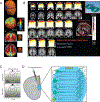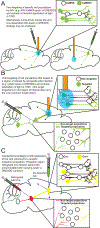Prefrontal cortex circuits in depression and anxiety: contribution of discrete neuronal populations and target regions
- PMID: 32086434
- PMCID: PMC7442605
- DOI: 10.1038/s41380-020-0685-9
Prefrontal cortex circuits in depression and anxiety: contribution of discrete neuronal populations and target regions
Abstract
Our understanding of depression and its treatment has advanced with the advent of ketamine as a rapid-acting antidepressant and the development and refinement of tools capable of selectively altering the activity of populations of neuronal subtypes. This work has resulted in a paradigm shift away from dysregulation of single neurotransmitter systems in depression towards circuit level abnormalities impacting function across multiple brain regions and neurotransmitter systems. Studies on the features of circuit level abnormalities demonstrate structural changes within the prefrontal cortex (PFC) and functional changes in its communication with distal brain structures. Treatments that impact the activity of brain regions, such as transcranial magnetic stimulation or rapid-acting antidepressants like ketamine, appear to reverse depression associated circuit abnormalities though the mechanisms underlying the reversal, as well as development of these abnormalities remains unclear. Recently developed optogenetic and chemogenetic tools that allow high-fidelity control of neuronal activity in preclinical models have begun to elucidate the contributions of the PFC and its circuitry to depression- and anxiety-like behavior. These tools offer unprecedented access to specific circuits and neuronal subpopulations that promise to offer a refined view of the circuit mechanisms surrounding depression and potential mechanistic targets for development and reversal of depression associated circuit abnormalities.
Figures



References
-
- Guilbert JJ. The world health report 2002 - reducing risks, promoting healthy life. Education for health (Abingdon, England) 2003; 16(2): 230. - PubMed
-
- Kessler RC, Berglund P, Demler O, Jin R, Koretz D, Merikangas KR et al. The epidemiology of major depressive disorder: results from the National Comorbidity Survey Replication (NCS-R). Jama 2003; 289(23): 3095–3105. - PubMed
-
- Greenberg PE, Fournier AA, Sisitsky T, Pike CT, Kessler RC. The economic burden of adults with major depressive disorder in the United States (2005 and 2010). J Clin Psychiatry 2015; 76(2): 155–162. - PubMed
-
- Trivedi MH, Rush AJ, Wisniewski SR, Nierenberg AA, Warden D, Ritz L et al. Evaluation of outcomes with citalopram for depression using measurement-based care in STAR*D: implications for clinical practice. The American journal of psychiatry 2006; 163(1): 28–40. - PubMed
Publication types
MeSH terms
Substances
Grants and funding
LinkOut - more resources
Full Text Sources
Medical
Miscellaneous

